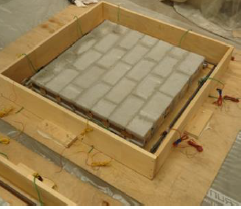1 PhD student, Faculty of Science & Engineering, Queensland University of Technology, Brisbane, QLD-4000, Australia, janaraj.thangarajah@student.qut.edu.au
2 Professor, Faculty of Science & Engineering, Queensland University of Technology, Brisbane, QLD-4000, Australia, m.dhanasekar@qut.edu.au
ABSTRACT
This paper presents an experimental study carried out on six masonry panels with different confinement configurations. Half scale hollow concrete blocks (195mm ×95mm ×95 mm gross), with 15.75 mm wide face shells and 5mm thick mortar joints were used to construct 655 mm square unreinforced hollow masonry test specimens that were confined with or without95 mm thick confining elements of either reinforced grout or reinforced concrete. Diagonal shear tests were carried out similar to the provisions in ASTM E519. A number of strains and deformations were measured with a view to examining the effect of confinement to the unreinforced masonry panel, and the behaviour of the confining elements as well as that of the unreinforced masonry panel. All panels were tested under displacement control. The results indicate that the reinforced concrete elements confine the unreinforced panels significantly better than the reinforced grouted elements.
KEYWORDS: unreinforced masonry, confined masonry, diagonal cracking, bed joint sliding cracking
351.pdf



